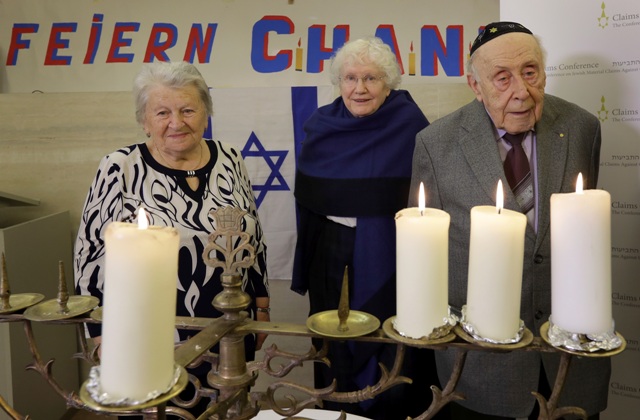Super Bowl travelers can learn stories of survivors of the Holocaust through an exhibit of photos and testimonials in Minneapolis, Minnesota, where the big game is being hosted.
By: Andrew Gershman, JNS.org
As thousands descend upon Minnesota for Super Bowl LII to see their heroes on the gridiron, some heroes they may not have expected to meet will greet them: Minnesotans who survived the Holocaust.
These survivors are featured in “Transfer of Memory,” a full-color photo exhibition on display in Minneapolis St. Paul International (MSP) Airport’s Terminals 1 and 2 through Feb. 5. The exhibit at MSP Airport is a partnership of the Jewish Community Relations Council (JCRC) of Minnesota and the Dakotas, David Sherman Photography, The Airport Foundation MSP and The Metropolitan Airports Commission. Transfer of Memory has traveled to venues throughout Minnesota, North Dakota, South Dakota, Wisconsin and Iowa since 2012.
Those travelers who stop to look at the exhibit may learn about Joe Grosnacht, 94, who survived Auschwitz, Buchenwald and several other camps, and whose tattooed number is visible on his arm, or about Eva Gross, 90, and her mother, Ella Weiss, who died in 2011. Together, the two survived six concentration camps, including Auschwitz, forced labor and death marches.
Son of survivors honors their memory
The Super Bowl’s connection to the Holocaust has its roots in the personal history of the owner and president of the Minnesota Vikings, Mark Wilf. The son of two Holocaust survivors from Poland, Wilf co-chairs the Jewish Federations of North America’s National Holocaust Survivors Initiative. The Vikings, Wilf Family Foundations and Delta Airlines supported the Transfer of Memory exhibit at MSP Airport. Wilf said, “We hope that the travelers visiting Minnesota for the upcoming Super Bowl will pause for a few moments to learn and reflect on this time in history that is deeply ingrained in the life of our family and world history.”
Photographer David Sherman, who had pitched the idea of a Holocaust survivor exhibition to the JCRC of Minnesota and the Dakotas about eight years ago, said his objective in taking the photos was “to create formal portraits of Holocaust survivors to ensure that survivors are remembered in a respectful and beautiful way—by face and by name, with an additional objective of documenting the stories of each of these survivors.”
Laura Zelle, one of the exhibit’s curators, said Sherman grew up hearing stories of survivors, often accompanied by black-and-white photos. He wanted to carry on the tradition of telling these stories but give them more life through color portraits. Lili Chester, a daughter of survivors, wrote the accompanying text for each portrait, which offers a short history in the survivors’ own words. Each survivor was photographed at home, and each was interviewed and videotaped prior to Sherman taking the portrait.
Launching the exhibit in MSP Airport presented Zelle and fellow curator Susie Greenberg with some challenges. For the first time, the exhibit needed to be split up due to space constraints. Nevertheless, one of the program’s key goals—bringing the stories of individual survivors to life—has already been accomplished. Of the 12 portraits featured in Terminal 1, more than two-thirds of those profiled attended the exhibit’s opening reception, along with their children and grandchildren.
Bringing lessons of the Holocaust far and wide
“This exhibition has enabled the JCRC’s Holocaust education program to bring lessons of the Shoah (Holocaust) to communities in Minnesota, North Dakota and South Dakota who otherwise might not receive firsthand accounts from Holocaust survivors. We thank everyone at the MAC (Metropolitan Airports Commission), Airport Foundation MSP, Minnesota Vikings, Wilf Family Foundations, and Delta Airlines for their leadership and tireless work to bring Transfer of Memory to MSP,” said Steve Hunegs, the JCRC’s executive director.
Zelle said notes left in the exhibit’s comment books have been “overwhelming.” She remembers one in particular that stated, “This is all of our history.”
Transfer of Memory is unusual in its reach. While a number of the survivors profiled for the exhibit have also been interviewed by the Shoah Foundation, this exhibit is small, portable and easily understood by middle and high school students, she said. The emphasis, said Zelle, “is a message of hope.” As JCRC’s description states, “the color images depict the survivors as living full and fulfilled lives—full of life and vitality—not defined by victimhood.”
Of the final portraits, Sherman said, “It is my hope and prayer that these images add an important visual proof to accompany the oral testimony. Today we stand at a critical time in regard to the Holocaust. After 70 years since the end of the war, we are in the midst of a ‘transfer of memory.’ The witness to the horrors, hardships, and brutalities of the Holocaust is shifting from those who saw and survived to a retelling of their testimony.”
More than 20 of the 52 Minnesotans profiled are now deceased, according to transferofmemory.org.
After the exhibit leaves MSP Airport, the next showing will be from Feb. 7-March 11 at the Basilica in Minneapolis. A complete schedule of upcoming exhibits is available at transferofmemory.org.


